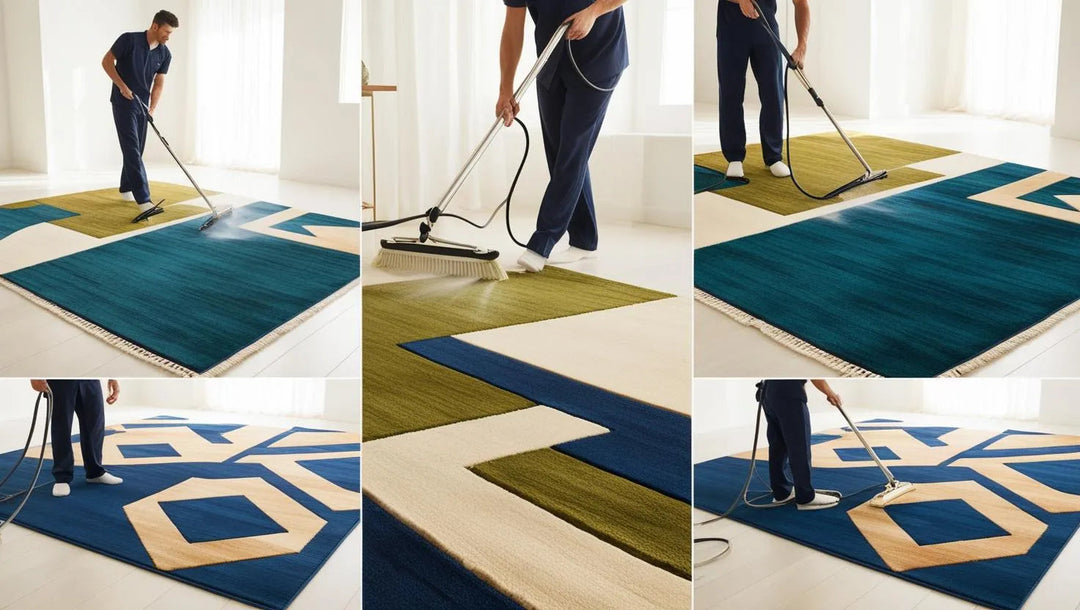How to Maintain and Clean Premium Modern Rugs
Introduction
Owning modern rugs can bring a fresh and stylish look to any room. These rugs are not only visually appealing but also serve practical functions, such as adding warmth, comfort, and a unique touch to your decor. However, like any premium home furnishing, modern rugs require regular care and attention to retain their original look and quality. In Australian homes, where lifestyle factors like pets, children, and outdoor connections often bring extra dust and dirt, keeping these rugs in top condition can be challenging without the right approach. This article will guide you through essential steps and tips for maintaining and cleaning your modern rugs, helping you make the most of your investment.
Maintaining modern rugs goes beyond just a weekly vacuum. Factors such as material, colour, and pile height determine how best to care for each rug. Whether you have a wool, jute, synthetic, or blended fibre rug, understanding the specific needs of each type is crucial for effective cleaning. This guide will cover various aspects of rug care, from simple daily upkeep to professional cleaning recommendations, ensuring your rug remains fresh, vibrant, and a beautiful focal point in your home for years to come.
By the end of this article, you’ll have a complete understanding of how to preserve your rug’s quality, texture, and appearance. Our aim is to provide you with practical advice that makes rug maintenance simple, stress-free, and effective, allowing you to enjoy a clean and attractive rug, no matter where it’s placed in your home.
Understanding Your Rug Type and Material
Each type of modern rug requires unique care methods. Identifying the material of your rug is the first step to ensuring it receives the correct maintenance. Here’s a breakdown of popular rug materials and their specific care needs:
a. Wool Rugs
Wool is a natural fibre known for its durability and luxurious feel. Wool rugs resist stains well, but they can be sensitive to moisture. For routine care, vacuum regularly using a brush attachment to prevent dirt from settling into the fibres. Avoid using excessive water or harsh chemicals on wool, as these can damage the fibres and cause shrinkage.

b. Synthetic Rugs (Polyester, Nylon, and Polypropylene)
Synthetic fibres are popular in modern rugs for their affordability and stain-resistant properties. They are generally easier to clean and more resistant to fading. Routine vacuuming and spot-cleaning with mild detergent are typically all that’s needed for synthetic rugs. However, be cautious with heat, as synthetic materials can warp under high temperatures.

c. Natural Fibre Rugs (Jute and Sisal)
Natural fibre rugs like jute and sisal add a rustic touch to home decor. While beautiful, these rugs are more sensitive to moisture and stains. Use a dry carpet cleaning method and avoid steam cleaning. For daily care, vacuum gently, avoiding the beater bar, as it can fray the fibres.

d. Blended Fibre Rugs
Blended fibre rugs combine materials, such as wool and synthetic fibres, to create a balance of durability and softness. Depending on the dominant material, care may vary. Refer to manufacturer instructions, and if in doubt, choose a mild approach to cleaning to avoid damaging the fibres.

Routine Maintenance: Keeping Your Modern Rug in Top Shape
Maintaining your rug’s appearance and longevity involves a few simple steps. Regular upkeep will prevent dirt buildup, reduce wear, and keep your rug looking fresh. Here’s how:
a. Vacuuming
Vacuuming is the most important part of rug maintenance. For high-traffic areas, vacuum twice a week to prevent dirt from becoming embedded in the rug’s fibres. For delicate materials, use a vacuum with a brush attachment or turn off the beater bar to avoid damage.

b. Rotating the Rug
Rotate your rug every six months to ensure even wear, especially if it’s exposed to sunlight or high foot traffic. This will prevent colour fading and areas of the rug from becoming worn out, preserving its look and texture over time.

c. Spot Cleaning Spills Immediately
When spills happen, address them right away. Blot (don’t rub) the spill with a clean, absorbent cloth, then apply a mild detergent if necessary. For deeper stains, use a mix of warm water and mild soap, but always do a spot test first to ensure the solution doesn’t damage the rug.

d. Using a Rug Pad
A quality rug pad placed underneath your rug can extend its life by absorbing impact and reducing friction. Rug pads also prevent slipping and help the rug stay in place, which is especially useful for lightweight rugs on hard floors.

Deep Cleaning Techniques for Different Rug Types
For a thorough clean, consider deep cleaning your rug every 12 to 18 months. Different types of rugs benefit from specific deep cleaning techniques:

a. Steam Cleaning
Steam cleaning is effective for synthetic rugs, as it removes embedded dirt and sanitises the fibres. Use a low-moisture setting to avoid soaking the rug, and let it dry completely to prevent mould growth. Wool and natural fibre rugs should not be steam-cleaned, as moisture can damage their structure.
b. Dry Cleaning for Wool and Natural Fibre Rugs
For wool and jute rugs, dry cleaning is a safer option. This method uses dry solvents that remove dirt without excessive moisture. Many professional rug cleaners offer this service and will ensure your rug is treated with the care it deserves.
c. Professional Rug Cleaning Services
Professional cleaning is recommended at least once a year, especially for high-value or large rugs. Professional cleaners have the expertise to handle different materials and stains effectively, restoring your rug to its original beauty.
Stain Removal Guide: Common Rug Stains and How to Tackle Them
Accidents happen, and knowing how to deal with stains effectively can make all the difference in maintaining your rug’s appearance. Here’s a quick guide on treating common stains:
a. Food and Drink Stains
Blot the spill immediately with a dry cloth to absorb as much as possible. Apply a mixture of mild detergent and water, blotting gently until the stain lifts. Avoid scrubbing, as it can embed the stain deeper into the fibres.
b. Pet Stains
For pet stains, blot the area with a cloth to remove as much liquid as possible. Apply a mixture of vinegar and water to neutralise odours, then rinse with warm water. Allow the area to air dry or use a fan for faster drying.
c. Mud and Dirt
Let the mud dry completely before vacuuming. For any remaining stain, use a mild detergent solution, applying it carefully with a cloth. Rinse with a clean, damp cloth to remove any soap residue.
d. Oil-Based Stains
Oil-based stains require a gentle solvent. Apply a small amount of dry-cleaning solvent to a cloth and blot the stain. Rinse with a damp cloth and repeat if necessary, but avoid using too much solvent, as it can damage certain rug fibres.
FAQs
1. How often should I vacuum my modern rug?
For high-traffic areas, it’s best to vacuum twice a week. In low-traffic areas, once a week is usually sufficient.
2. Can I use steam cleaning on all types of rugs?
No, steam cleaning is ideal for synthetic rugs, but it can damage wool, jute, and other natural fibres. Opt for dry cleaning methods or professional services for these materials.
3. What should I do if my rug develops an odour?
Sprinkle baking soda over the rug, let it sit for a few hours, then vacuum it up. For persistent odours, professional cleaning may be necessary.
4. Are there eco-friendly ways to clean my rug?
Yes, using natural solutions like vinegar, baking soda, and mild soaps can be effective for spot cleaning. These methods are safe and reduce chemical exposure.
5. When should I consider professional rug cleaning?
For large, high-value, or delicate rugs, professional cleaning once a year is ideal. It removes deep-seated dirt and extends the rug’s life.
Conclusion: Keeping Your Modern Rug Beautiful
Maintaining and cleaning modern rugs doesn’t have to be complicated, but understanding the needs of your rug’s material and structure is key. By following these cleaning tips and practices, you’ll be able to keep your rug looking beautiful and in excellent condition for years. From vacuuming and spot-cleaning to selecting the best cleaning method for each material, the care you invest in your rug will pay off in terms of durability, comfort, and style.




